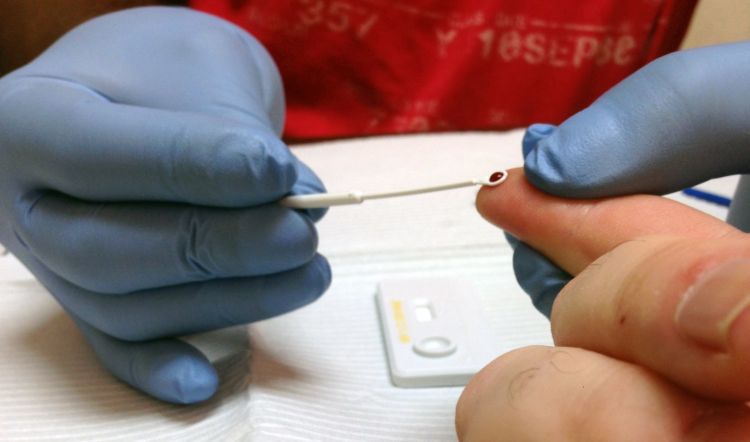Analyzing a HIV testing strategy that uses social referrals


As a public health measure, HIV testing is an essential strategy. Undiagnosed HIV infection is thought to account for one- third of HIV transmissions in the United States, and the Centers for Disease Control and Prevention (CDC) estimates that 15 percent of individuals living with HIV are unaware of their infection. The proportion of undiagnosed infection is higher among youth ages 13-24 and people of color, resulting in health inequities.
Undiagnosed HIV causes a vulnerable and potentially prolonged period of time for transmission opportunities. “HIV testing serves both to identify undiagnosed cases of HIV and link individuals to care that promotes their life and prevents spread of the disease,” explained Ryan Westergaard, MD, PHD, MPH (pictured at right), associate professor, Infectious Disease. The mainstay strategy for HIV testing is called counseling, testing, and referral to care (CTR), in which community-based agencies receive funding from the CDC for HIV testing programs. Agencies have autonomy to define how their testing services will be implemented in ways that are optimized for a defined target population.
As a result, CTR programs use a range of recruitment methods. One recent variation is called social networks testing (SNT), a peer-based strategy in which people at high risk for or living with HIV (recruiters) are enlisted to recruit individuals from their social, sexual, and drug-using networks (network associates) for HIV testing. In New York City, this strategy yielded better results for detecting HIV infection among a group at high risk for HIV - Black men who have sex with men (MSM). However, outcomes of the SNT strategy had not been systematically studied in Wisconsin, even though it had been supported by the Wisconsin Division of Public Health since 2008 and was being used in various locations around the state.
To shed light on SNT outcomes in Wisconsin, Dr. Westergaard led a study with collaborators from the HIV/AIDS Program in the Wisconsin Department of Health Services – Division of Public Health and the Center for AIDS Intervention Research at Medical College of Wisconsin. The work was related to federal funding that Wisconsin received in 2011 to develop, pilot, and evaluate innovative models of HIV testing and care to improve knowledge of serostatus, linkage to care, retention to care, and viral suppression. It included implementation of a standardized protocol in Wisconsin for SNT. Outcomes were studied at 18 CTR sites across the state for a period of two years (2013-2015). “The results were informative for developing evidence-based testing and recruitment strategies in the future that are likely to be applicable to populations in Wisconsin,” said Dr. Westergaard.
Of the 19,095 HIV tests conducted at the 18 CTR sites during the two-year study period, 1,232 individuals were tested through SNT and 14,595 were tested by other CTR standard methods. Twelve of the sites used the SNT standard protocol. Demographics and HIV risk factors differed significantly between the SNT and non-SNT groups. SNT attracted more people who were younger than age 24, who were Black, or whose HIV risk factors were men with a history of sexual encounters with other men or a history of injected drug use.
There was no difference in the seropositive test rate (positivity rate) between the STR and non-STR groups; each was close to 0.5 percent. “That was expected, because other studies in other geographic regions had also shown no significant differences between SNT and other targeted testing programs,” said Dr. Westergaard.
The primary value of STN in Wisconsin seems to be its ability to reach certain populations, such as Black MSM or people who inject drugs, and individuals testing for the first time. “This suggests that it may take different techniques to reach different high-risk sub-groups, which is valuable information for agencies and public health officials to consider when making funding and policy determinations,” said Dr. Westergaard. “Preventing HIV transmission can sometimes require deployment of more than one strategy.”
However, the study also revealed some cautionary information, particularly from qualitative findings gathered from interviews with staff members at agencies and the Department of Public Health.
“SNT programs are more time-consuming and complicated to administer, and staff discussed this burden in context of their other prevention work,” said Dr. Westergaard. Despite the use of a standardized protocol, implementation of SNT with fidelity remained a challenge, with some centers increasing the value and type of testing incentives (gift cards) that were offered to participants.
The authors noted that other SNT programs have been implemented in high-density, large metropolitan areas with high prevalence of HIV such as Neyw York City, Seattle, and Washington, DC. “Wisconsin is different, with lower prevalence, smaller cities and a more dispersed population overall. We think that oversaturation of SNT sites in a relatively small geographic area may have limited further success,” said Dr. Westergaard.
However, the authors urged that SNT still holds value for reaching certain sub-groups. “SNT was successful at reaching high-risk individuals who may not otherwise engage in HIV testing. This is important to know from both a public health perspective and a health equity perspective,” said Dr. Westergaard.
Additional authors were Casey Schumann, Jacob Dougherty, Megan Elderbrook, and James Vergeront (Wisconsin Department of Health Services); Danielle Kahn, MSPH (UW-Madison Department of Medicine, Division of Infectious Disease); and Michelle Broaddus (Medical College of Wisconsin). Funding was provided by the Health Resources and Services Administration (HRSA) of the US Department of Health and Human Services.
Resources:
- Schumann C, Kahn D, Broaddus M, Dougherty J, Elderbrook M, Vergeront J, Westergaard R. 2018. Implementing a Standardized Social Networks Testing Strategy in a Low HIV Prevalence Jurisdiction. AIDS and Behavior. [Epub ahead of print]
Photo (top): A rapid HIV test is administered at a clinic in Michigan. Public domain image CC-SA-3.0